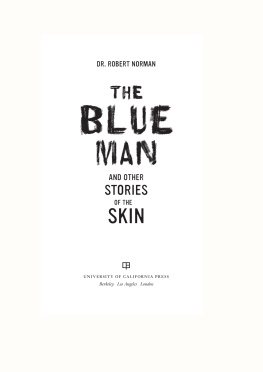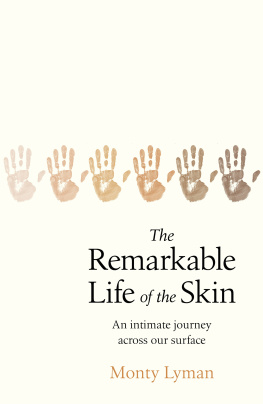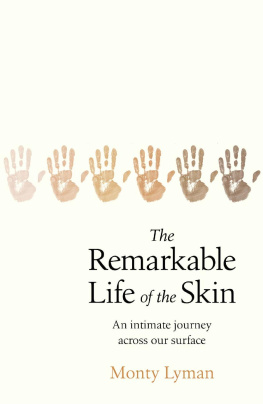
Praise for The Blue Man and Other Stories of the Skin
How does our skin define us? In The Blue Man, dermatologist-author Robert Norman not only provides an entertaining and informative overview of how our skin shields us from harm but also provides clues that disease may be running amok in our bodies. The Blue Man will appeal to all those who make the health and care of skin their business and to general readers seeking to learn more about the bodys largest organ.
Rita Ciresi, author of Pink Slip and Bring Back My Body to Me, Professor of English and Director of Creative Writing, University of South Florida
Lucid and appealing, The Blue Man is an introduction to a topic that almost all of us are interested in: our skin. Dr. Norman is a well-recognized expert in dermatology. For students interested in medical narrative, certain chapters would be required reading.
David J. Elpern, M.D., Editor, The Online Journal of Community and Person-Centered Dermatology ( OJCPCD )
Dr. Robert Normans The Blue Man describes real-life dermatological detective stories that reveal the skin as a complex and mysterious creature and the practicing physician as both detective and epidemiologist. This book educates and entertains, illustrates and illuminates, and improves our understanding of the skinour largest organ and the link between our bodies, the environment and other organisms. Read this book and enter the curious and fascinating world of skin.
Sharad P. Paul, M.D., author of Skin: A Biography
Skin diseases may create great physical, mental, and emotional suffering. Dr. Robert Norman writes about these afflictions with insight and compassion.
John E. Wolf, Jr., M.D., M.A., Professor and Chairman, Department of Dermatology, Baylor College of Medicine
Human skin, serving as the interface with the environment, is not only an important barrier, but it is also a major contributor to social and cultural interactions. Thus, in addition to considerations of disease, there is much to reflect on the skins greater role in our lives. While the biomedically oriented physician may focus on making the right diagnosis and prescribing the right therapy, the humanistic physician sees the big picture, the stories of peoples lives in which the skin plays a prominent role. Leading dermatologist Dr. Robert Normana man of science, letters, and soundshares these stories, educating us on the basic science underlying this remarkable organ while demonstrating the lessons it has to share with us in our interpersonal lives.
Steven R. Feldman, M.D., Ph.D., Department of Dermatology, Wake Forest University School of Medicine
Dr. Normans stories about our skin range from its vital physiological functions to its behavior in our everyday lives. The book is a beautifully written account that celebrates the bodys largest organ. Dr. Norman frequently uses the eye of a naturalist to provide comparisons between the behavior of skin and what occurs around us in nature to emphasize his points. A delightful read!
Irwin M. Braverman M.D., Professor Emeritus of Dermatology, Yale Medical School
Dr. Norman is a born raconteur. He has taken his literary skills to new heights in gathering together stories about the skin and has capably used them to illustrate various dermatologic observations and findings.
Lawrence Charles Parish, M.D., M.D. (Hon.), Editor in Chief, Clinics in Dermatology and SkinMED
THE BLUE MAN
AND OTHER STORIES
OF THE SKIN
DR. ROBERT NORMAN
THE
BLUE
MAN
AND OTHER
STORIES
OF THE
SKIN

UNIVERSITY OF CALIFORNIA PRESS
BerkeleyLosAngelesLondon
University of California Press, one of the most distinguished university presses in the United States, enriches lives around the world by advancing scholarship in the humanities, social sciences, and natural sciences. Its activities are supported by the UC Press Foundation and by philanthropic contributions from individuals and institutions. For more information, visit www.ucpress.edu.
University of California Press
Berkeley and Los Angeles, California
University of California Press, Ltd.
London, England
2014 by The Regents of the University of California
Library of Congress Cataloging-in-Publication Data
Norman, Robert A., 1955.
The blue man and other stories of the skin / Robert A. Norman.
p. ; cm.
Includes bibliographical references.
ISBN 978-0-520-27286-6 (cloth : alk. paper)
eISBN: 978-0-520-95250-8
1. Skin Physiological Phenomena.2. Skinpathology.3. Skin Diseases.I. Title
RL 96 2014
616.5dc23
2013033771
Manufactured in the United States of America
23 22 21 20 19 18 17 16 15 14
10 9 8 7 6 5 4 3 2 1
The paper used in this publication meets the minimum requirements of ANSI/NISO Z 39.481992 ( R 2002) (Permanence of Paper) .
For Howard
CONTENTS
PREFACE
To cure sometimes, to relieve often, to comfort always.
Attributed to Edward Livingston Trudeau
Throughout my medical career, I have kept two sets of records: one of patients clinical notes, the other of patients stories. Along the way, I began to write my own stories. I have hammered out essays for Discover magazine, written and edited five textbooks of dermatology, and been a preceptor for a few hundred medical residents, medical students, and undergraduate students who ask endless questions and increase my own knowledge while feeding their own.
This book focuses on the dynamic qualities of the skin and the people who inhabit it. Included are stories about the life of the skin, tales of fascinating and mysterious patients, meditations on cultural issues including skin color, and thoughts about the future of the skin. I try to speak for the skin, since it cannot speak for itself, and show you how lucky we are to have such an amazing natural covering. Our skin is our partner, nourishing and protecting us, teaching us about the world, and serving as a record of our lives. We should take the opportunity to learn what the skin has to teach and how we can best serve each other.
Each day I try to heal the pain, both psychological and physical, that illness of the skin causes people. As a physician, I am often required to peel away possibilities to get to the source of my patients medical problem and repair what has been disturbed or broken. Each problemand each appointmentis preceded by a story. Recently a man came to see me complaining about a growth on my arm giving me pain. In the exam room, my medical assistant gently pulled off the mans ragged, home-rigged dressing and revealed a profusely bleeding half-dollar-sized skin cancer. I let him know that I could surgically remove it right then, and he agreed. But beyond this nasty growth I could envision a whole history, including a lack of funds and transportation, that had kept him from seeking a remedy. A few days later an eight-year-old girl came to my office with severe atopic dermatitis and a horrible itch. She had been out of school for three weeksand her mother had been unable to go to work during much of that time, due to lack of sleep and trying to care for her child. With each patients story, the narrative proceeds to a resolution and hopefully some relief from the burden of a disease that elicits pain, itch, or other disturbance in quality of life for the patient and family.
On many days, my primary role is that of a nurturer. I often have to explain that many skin diseases are chronic in nature and only palliative care can be provided. Although there may be a perception that skin conditions only minimally affect patients, those who have protracted and severe conditions often endure serious psychosocial repercussions. All the activities of daily livingincluding work, sleep, hobbies, and social contactmay be harshly disturbed. Using the Dermatology Life Quality Index, the Beck Depression Inventory, and other quality-of-life measures, researchers have confirmed that those suffering from prolonged skin disease often endure significant impairments of work, school, and personal relationships.
Next page



















